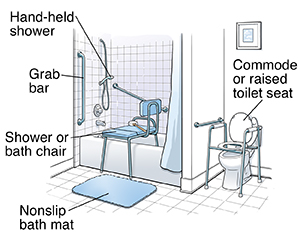If your movement is limited during recovery, ask a family member or friend to help prepare your bathroom. This helps make it safer and more comfortable while you heal. Use the tips below as a guide. Know that some equipment you’ll need won’t be ordered until you’re ready to go home.
Bathroom safety tips
Try the following tips for staying safe:
-
Prevent slips and falls by using nonslip bathmats on your bathroom floor and in your tub or shower.
-
Watch out for hazards, such as wet floors.
-
Use grab bars in your shower or tub for support as you get in and out. Also have them by your toilet.
-
Install a hand-held shower hose.
-
Keep the soap and shampoo within reach
-
Sit on a bath bench or shower chair while you bathe.
-
Use a long-handled sponge to wash hard-to-reach areas.
-
If you had surgery that limits bending, use a commode chair or elevated toilet seat to raise the height of your toilet.
-
Talk with your occupational therapist if you need more instructions in using bath aids.
Featured in


